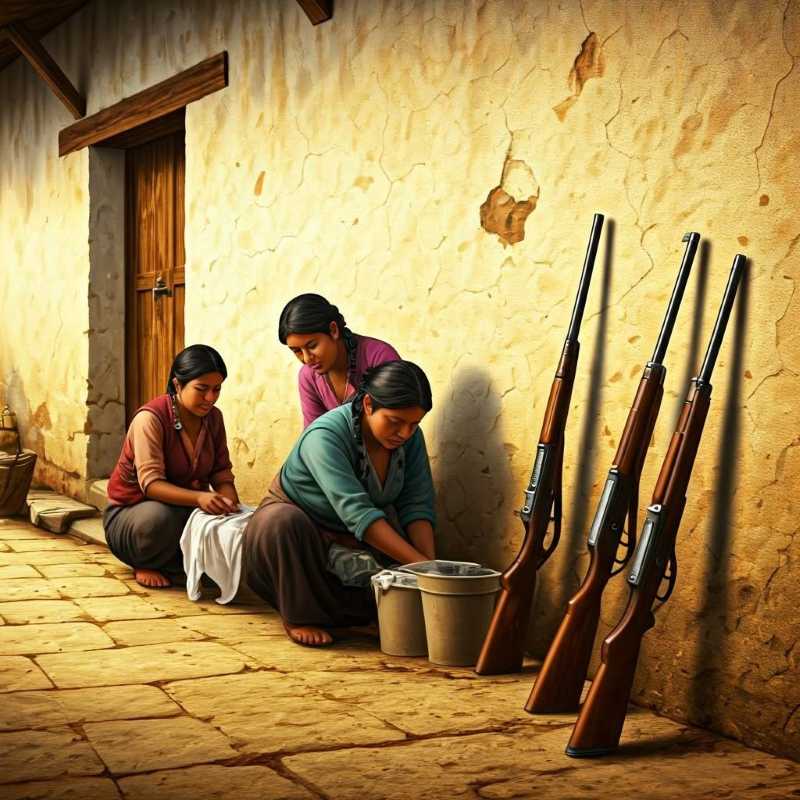The Soldaderas: How Women Won the War (and Did the Dishes)
María Encarnación Mares, a woman who defied societal norms, joined the Mexican Revolution as a Soldadera, a warrior woman. These women, often overlooked, played a crucial role in the fight for freedom, serving as soldiers, caregivers, and providers.

Look, Isidro. Look. I’d rather face a firing squad than follow you into battle. It’s a line that hangs in the air, thick with the humid Veracruz heat, a line that, as María Encarnación Mares recounts, etched itself onto her husband’s face with a shock so profound it’s still palpable across the decades. A husband, presumably expecting the quiet acquiescence of a wife in a time that demanded it. But María Encarnación Mares, as we learn from Martha Eva Rocha Islas’s meticulous research in History of Women in Mexico, was not a woman built for acquiescence. She was built for something else entirely: for defiance, for action, for the carbine that would soon rest against her shoulder, for the horse that would carry her into the heart of the Mexican Revolution.
This isn’t a story of delicate embroidery or whispered prayers. This is a story of calico petticoats stained with dust and gunpowder, of hands that held both a grocery bag and a Mauser, of women who were, as Elena Poniatowska so eloquently put it in Las soldaderas, “the very image of weakness and resistance.” And isn’t that the very essence of the human condition, distilled into its purest, most brutal, and most beautiful form? The simultaneous existence of fragility and fortitude, woven together like the threads of a well-worn shawl?
We talk about the Mexican Revolution, the grand narratives of Villa and Zapata, the sweeping pronouncements and the thunder of hooves. We see the iconic images: the mustachioed generals, the charging cavalry, the dusty landscapes. But what about the women? What about the Guahcas, the Indias, the Galleas, the Juanas, the Marías, the Adelitas – the names they carried like secrets across the vast expanse of the country? Names that, as Rocha Islas’s work reveals, shifted and changed with the regions, a testament to the sheer breadth and diversity of their presence.
These weren’t just camp followers, these weren’t simply the wives and daughters trailing behind the men. To reduce them to mere cooks and caregivers is a grotesque disservice, a historical travesty. They were the backbone of the revolution, the unseen army that kept the wheels turning, the engine running. They were the quartermasters, the medics, the strategists, the spies. They were the ones mending uniforms under the flickering light of a campfire, the ones foraging for food in desolate landscapes, the ones nursing the wounded under the constant threat of attack. And yes, they were also the ones who picked up arms, who stood shoulder to shoulder with the men, who fought and bled and died for the cause.
Poniatowska’s description is haunting: “With their calico petticoats, their white blouses, their washed faces, their lowered gaze, so that shame cannot be seen in their eyes, their candor, their modest attitudes, their dark hands holding the grocery bag or getting ready to hand the Mauser to their companion…” It’s a portrait of quiet strength, of resilience born not of grand pronouncements but of necessity. The lowered gaze, not of submission, but perhaps of a weariness that stretches beyond comprehension, a knowledge of the brutal realities of war etched into their very being.
And then there’s that image: “Wrapped in their shawl, they carry the child and the ammunition…” The child, a symbol of hope, of the future, nestled against the tools of destruction, the instruments of war. It’s a stark juxtaposition, a reminder of the impossible burdens these women carried. They were mothers and soldiers, nurturers and fighters, all at once. They embodied the paradox of war, the way it simultaneously destroys and creates, the way it forces ordinary people to become extraordinary.
“Their smallness,” Poniatowska writes, “like that of the indigenous people, allows them to survive.” It’s a poignant observation, a recognition of the way marginalized communities have always found strength in their perceived weakness. They were underestimated, overlooked, dismissed. And in that invisibility, they found their power. They moved through the shadows, unseen and unheard, but their impact was undeniable. They were the silent force that propelled the revolution forward.
They Wore Pants (and Carried Guns)
Let’s talk about the women who weren’t just around. The women who were in it. The women who picked up guns, not ladles. The women who didn’t just mend wounds, they inflicted them. The women who, to borrow a phrase, did not come to play.
Because while we’re all familiar with the sepia-toned images of women in rebozos, hovering on the periphery of the revolution, there’s a much more complicated, much more interesting, story lurking in the dusty archives. A story of women like Elodia Arce, Petra Leyva, Elena Arizmendi, Elena Torres Cuéllar, Laura Orellana – names that, until recently, whispered into the void of history, are now being dragged, kicking and screaming, into the light. These were not just names on a list. These were soldiers.
The distinction is crucial. It’s not about belittling the crucial work of the soldaderas or the Adelitas. Their contributions were essential, undeniable. But these women… these were different. They weren’t just supporting the war effort. They were the war effort. As the research suggests, these women, by taking up arms, “challenged men for the exclusivity of the military space of war.” They didn’t just enter that space. They invaded it. And they did so, paradoxically, “as men (clothing, codes, attitudes).” They adopted the trappings of masculinity not as a performance, but as a necessity. They needed to be seen as equals, as fighters, not as… well, not as women. Not as they were expected to be.
Because what does it mean to be a woman in a revolution? What does it mean to pick up a rifle when the entire structure of society is telling you to pick up a broom? It means, as the research astutely points out, being “doubly rebellious social subjects: rebellious to the policies of the regime and rebellious to gender affiliation.” They weren’t just fighting against a political system; they were fighting against the very definition of womanhood. They were rewriting the script in real time, with bullets and blood.
And this wasn’t some small, insignificant movement. These women weren’t just hiding in the shadows. They were leading. They were commanding. They were earning ranks. We’re talking about women who rose to the rank of colonel. Colonel! Can you imagine? In a society so rigidly defined by gender roles, a woman holding the rank of colonel is an act of sheer, unadulterated defiance. It’s a middle finger to the patriarchy written in gunpowder.
But, of course, the patriarchy doesn’t take kindly to middle fingers. Especially not ones wielded by women with guns. And so, predictably, there was a backlash. Circular number 78, issued on March 18, 1916, declared all military appointments given to women “null and void.” Just like that. Poof. Gone. As if their service, their sacrifice, their very existence as soldiers could be erased with a stroke of a pen. A year later, Venustiano Carranza formalized this erasure, formally discharging women from the army, conveniently forgetting their “active participation in the battlefields.”
These Women Were Everything
If you think your book club gets heated over who gets to bring the rosé, you haven’t seen anything. We’re talking 1911, 1912. Women! Forming clubs! Distributing propaganda! Hiding weapons in the folds of their dresses! It's like a historical drama waiting to happen, except it already happened, which is, like, so much more amazing.
It’s almost unfathomable, the sheer volume of political clubs and anti-reelection groups that sprang up during this period. Like, did they have a group chat? Because the organizational skills alone are giving me life. We’re talking the Revolutionary Junta of Puebla—iconic, obviously—the Josefa Ortiz de Domínguez Anti-Reelection Women's League (named after a legend, naturally), the Grupo Magisterial Revolucionario. And then, the clubs. The women’s clubs. Because, yes, the men were off doing… whatever it is men do in revolutions (probably strategizing and pointing at maps, I imagine), but the women? They were organizing. They were mobilizing. They were, dare I say, slaying.
We have the Gertrudis Bocanegra club in Mexico City, led by the divine María de los Ángeles Méndez. We have the Daughters of the Revolution, with the equally fabulous Elodia Arce Arciniega at the helm. And then, Carmen Serdán in Puebla. I mean, the names alone. They sound like characters from a telenovela, but, like, a really good one, one with, like, important historical subtext. And that’s just a sampling. There were more! In Acayucan, Veracruz, and, like, everywhere, apparently. Imagine the meetings! The passionate whispers! The perfectly coordinated distribution of… well, of everything.
Their propaganda? It wasn’t just, like, little pamphlets. It was lectures. They were coordinating entire anti-reelection campaigns against Díaz. They were holding clandestine meetings. They were basically the original influencers, but, you know, with actual stakes. They weren't just criticizing the Porfirian dictatorship on Twitter (because, obviously, Twitter didn’t exist then, but, like, imagine). They were actively working to dismantle it.
And the propaganda wasn’t just words. It was action. Mercedes Arvide, a member of the Daughters of Cuauhtémoc club, said that they were “seeking to let the public know that in the opposition there were also women campaigning like men.” But, like, better than men, probably. Because they weren’t just campaigning. They were encouraging people to vote. They were watching over polling stations. They were making sure things were done right. Because, let’s be real, if you want something done right…
And the clandestine tasks? Oh. My. God. One 16-year-old girl (a teenager!) was able to “outwit the police and the Porfirian forces” by carrying “communications, ammunition, weapons in the folds of her dress.” In the folds of her dress! It’s like something out of a spy movie, except it’s real. Her house was searched multiple times, but, like, they never found anything, because, obviously, these women were geniuses.
Pablo Yankelevich, professor emeritus of El Colegio de México (so, you know he knows what he’s talking about), said that thanks to these women, we understand that “a military strategy is as important as effective propaganda work.” But, like, let’s be honest, the propaganda was the strategy. The words, the lectures, the pamphlets, the presence of these women—it was all part of a larger plan. And it worked.
They Held Hands, They Found Ether, They Demanded the Vote
While the official Red Cross, bless its bureaucratic heart, was busy wringing its hands over “insufficient equipment” (which, in historical hindsight, translates to “we don’t want to deal with this mess”), women like Elena Arizmendi and her colleagues in the Neutral White Cross were elbow-deep in the actual mess: the blood, the bandages, the sheer, gut-wrenching reality of war. These weren’t just “helpers,” these were nurses, some trained, some not, but all driven by a ferocious sense of duty that frankly puts most of us to shame. Imagine: Chihuahua, the chaos of battle, wounded Maderistas crying out, and these women, these warriors in their own right, improvising, always improvising, because when you’re facing a shortage of everything, ingenuity becomes your best weapon.
And it wasn't just the Neutral White Cross. The Villistas, those famously rebellious fighters, had their own health service, the Health Brigade of the Northern Division. Think less pristine operating rooms and more repurposed railway cars, transformed into makeshift hospitals. Tables meant for cargo now serving as operating tables, medicine bottles perched precariously on… well, whatever they could find. And at the heart of it all? Women, volunteers, working without pay, not just tending to the wounded but actively procuring the supplies they needed. They were the supply chain, the medics, the emotional support, all rolled into one.
There’s this image, relayed by the nurse Leonor Villegas, of her colleague Mimi Echauzier, “working tirelessly, carrying clothes, assisting in operations, desperate to find ether or chloroform.” Isn’t that just the most evocative phrase? Desperate. It speaks to the sheer urgency of the situation, the life-or-death stakes these women were dealing with every single day. And then, the most human of touches: “she held the hand of the sick to give them courage while they were being operated on.” Because in the face of unimaginable pain and fear, sometimes a human touch is the only medicine that truly matters.
But the story doesn’t end there. Because these women weren’t just content to patch up the wounds of war. They were also fighting a war of their own, a war for equality, for recognition, for basic human rights. We’re talking about the feminists of the Mexican Revolution, women like Elena Torres Cuéllar, Elvia Carrillo Puerto, Rosa Torre González, Hermila Galindo Acosta, and a whole host of other names that, frankly, deserve to be on the tip of everyone’s tongue.
These weren’t just women who happened to be around during a revolution. They were shaping it. They were demanding rationalist schools (because who needs tradition when you have reason?), mixed-gender education (scandalous!), sexual education (double scandalous!), equal pay (gasp!), and, of course, the holy grail: women’s suffrage. They were envisioning a completely different Mexico, a Mexico where women weren’t just seen but heard, where they weren’t just tolerated but celebrated.
And here’s the thing: they won. Not all at once, of course, but their tireless work, their unwavering commitment, laid the groundwork for the transformation of Mexican society. They fought for the right to vote, for equal salaries, for a seat at the table. They proved, beyond any doubt, that revolutions aren’t just fought on battlefields; they’re fought in hospitals, in classrooms, in the hearts and minds of women who refuse to be silent.
In-text Citation: (Espinosa Torres, 2024, pp. 25-28)




